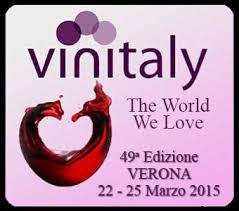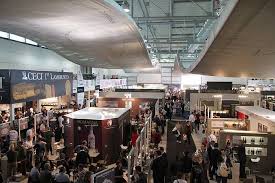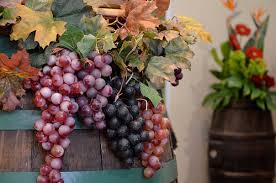Vinitaly has asked several buyers in some of the most important and interesting markets about prospects for wine exports. Things are promising for everyone, despite changes in scenarios in some countries and the need to find the right approach to various situations. There are opportunities in France thanks to the excellent quality/price ratio of Italian wines. Traders set to travel to Verona from 120 countries.
 Verona, 13 March 2015 – At just two weeks from its opening day, Vinitaly has surveyed the sentiments of buyers from China, Vietnam, South Korea, Brazil, Mexico, Australia, United States, Canada, United Kingdom, Germany, Sweden, Denmark, Holland, Belgium and France. This is a “foretaste” of the focus meetings dealing with target countries scheduled during the international landmark wine show next 22-25 March at Veronafiere (www.vinitaly.com). Major exhibitors have great expectations, thanks to the stronger than ever incoming promotion by Veronafiere which will ensure attendance by trade delegations from 50 countries for b2b meetings scheduled with companies and the arrival of wine and food professionals from 120 Countries.
Verona, 13 March 2015 – At just two weeks from its opening day, Vinitaly has surveyed the sentiments of buyers from China, Vietnam, South Korea, Brazil, Mexico, Australia, United States, Canada, United Kingdom, Germany, Sweden, Denmark, Holland, Belgium and France. This is a “foretaste” of the focus meetings dealing with target countries scheduled during the international landmark wine show next 22-25 March at Veronafiere (www.vinitaly.com). Major exhibitors have great expectations, thanks to the stronger than ever incoming promotion by Veronafiere which will ensure attendance by trade delegations from 50 countries for b2b meetings scheduled with companies and the arrival of wine and food professionals from 120 Countries.
“Contact with markets,” explains Giovanni Mantovani, CEO & Director General of Veronafiere, “is fundamental in understanding trends and providing companies with the information and services they really need and thereby make informed decisions year by year as regards where efforts should be made to attract incoming buyers, that for 2015 has seen our investments up by 34%. This is why Vinitaly, with Vinitaly International, is an exhibition ‘open’ all year round, travelling from Verona to China, the USA, Canada and other countries to return home with a wealth of contacts and know-how. An unthinkable task for companies, which thereby makes Vinitaly an eagerly awaited business occasion for wine cellars.”
The best feedback from the survey comes by historic partners, such as Germany, the United States and Great Britain. India, on the other hand, is complicated to say the least, and Russia, despite holding up in 2014, is experiencing the worst devaluation of the rouble in recent years, while very high duties are paid in Brazil.
Inasmuch, a two-speed and constantly changing world view.
Positive sentiment. This virtual tour around the wine trade “Atlas” has evidenced distinctly positive sentiments but continued growth can only be achieved after learning how to approach different countries and geographical areas.
In China, for example, it is important for us to exploit the setbacks affecting France in 2014 by “working to build strong brands”, according to David Chow, of Altavis Fine Wines, because this, for Italian wines “is a new era of development, as long as reasonable prices are on offer”. So, more emphasis on quality wines such as Barolo, Barbaresco, Brunello di Montalcino and Amarone della Valpolicella, which are increasingly popular in China, says importer Hideyuky Tsuji of Enoteca Shanghai Co.
 Yet Asia is not only China and even small countries such as Vietnam are coming through. Here, says Nguyen Dui Tuan of Top Wine Director, “the wine market has grown very quickly and the protagonists were France and Italy but we have to take into account the polarization of consumption, ranging from bottles at less than two euros and other costing more than twenty”. Even South Korea is “seeing the French wine bubble bursting and people are looking more at Italian wines, which are more accessible, “says Shang Mang Woon of World Liquor Co.
Yet Asia is not only China and even small countries such as Vietnam are coming through. Here, says Nguyen Dui Tuan of Top Wine Director, “the wine market has grown very quickly and the protagonists were France and Italy but we have to take into account the polarization of consumption, ranging from bottles at less than two euros and other costing more than twenty”. Even South Korea is “seeing the French wine bubble bursting and people are looking more at Italian wines, which are more accessible, “says Shang Mang Woon of World Liquor Co.
In Brazil “Tuscan red wines are doing well, as well as Lambrusco and Franciacorta sparkling wines,” says Almir Luppi Dos Anjos of Epicerie De Bebidas Ltda, “but the most problematic aspect is that of tax pressure, which is very high in Brazil so that the average price of the bottles we buy is around two-three euros.”
Moving up South America, one of the best-performing countries is Mexico, where “the culture of wine is expanding very quickly, especially when it comes to Italian wine – which is enjoying constant growth, from Tuscan labels to those of Northern Italy, such as Amarone della Valpolicella, with an eye also on wines from the South,” says Victor Osbaldo Treviño Rincon of Value Wine S.A De C.V, who also stresses that the “average price is around 12-22 dollars, while at the lower end there is no competition with wines from Argentina and Chile”.
Back in the southern hemisphere, there is a country capable of being, at one and the same time, a competitor and a partner: Australia, where the passion for Italian wine was initially based on the passion of Australians for ‘il Belpaese’, increasingly chosen as a destination for their vacations “and when they returned to Australia they wanted to continue drinking the extraordinarily different wines discovered during their trip,” explains Robert Damato of Casa Italia Gourmet. “It takes open-mindedness to appreciate Italian wine fully as well as a desire for discovery, from organic wines to Chianti, by way of Nero d’Avola, knowing full well that we ourselves are the first competitor”.
Still outside the old continent, our stronger trading partner is, without a doubt, the United States, where “widespread Italian dining is the first means of promoting wine,” explains Ramin Dabiri of Vitis Imports, “not to mention awareness and familiarity with many the different denominations, so that alongside more established labels wines are also beginning to emerge from Sicily, Apulia and Montepulciano d’Abruzzo for reds, and Alto Adige and Friuli for whites. In the wake of the recession, however, people are spending a little less, so while the $10-25 dollar band is still going strong, things become more difficult over the $40 price tag.”
 North America does not only mean the United. In fact, by now in Canada “Italian wine has become more important than French, thanks largely to wines from Piedmont, Tuscany and the Veneto,” says Jean Louis Fortier of Defori Selections, “but it must be borne in mind that wine here is very expensive: if a bottle in Italy costs 4-5 euros, it costs 25 dollars in Canada.”
North America does not only mean the United. In fact, by now in Canada “Italian wine has become more important than French, thanks largely to wines from Piedmont, Tuscany and the Veneto,” says Jean Louis Fortier of Defori Selections, “but it must be borne in mind that wine here is very expensive: if a bottle in Italy costs 4-5 euros, it costs 25 dollars in Canada.”
This particular tour closes with the Old Continent, where Italian wine has been known for centuries. As in the United Kingdom, where, nonetheless “there is still a great deal to be done as regards promotion, even though certain regions are emerging strongly such as Tuscany, Montecucco, Maremma and Morellino but,” as Peter Ingram of Vagabond Wines says, “the market is also rewarding white wines with a strong character, such as Timorasso”. And while Prosecco “will continue to perform well, I see great difficulty for classic method wines, which will not be able to knock Champagne off its position of leadership”.
Germany no longer holds surprises in store, where “Italian wines cover an important share of the market,” says Nikola Birker of Vino Donino, “with an offering taking in every region and almost every reasonable price range”.
There is also good feedback from Sweden where, according to Giovanni Brandimarti of Ward Wines Sweden, “we must not look to France but keep an eye on the growth of Spain; without undue concern but by enhancing the good things we have to offer”. The key success in Denmark, however, lies in food pairing: “Italian wine is fine with an average price of around 5-8 euros and consumers appreciate it a great deal because it matches our food well,” says Erik Sekkelund Andersen of Cavalcade Wines.
Italy is also catching up with France in Holland, where “price is an important variable,” says Enrico Hujbrechts of Dewijniengel Wijnkoperij, “better still at less than 10 euros – but always bearing in mind that real added value is the huge variety”. Things are tougher in Belgium, where competition with France is still not on an equal footing but consumers,” as Karel Wilmots of Kwart Cgv explains, “are very well informed and know how to recognize and reward the right quality/price ratio across all price ranges regardless of where the wine comes from”.
As ever, France is the eternal rival, albeit not the only one, and yet, even here, there is a consumer niche which appreciates Italian wine “coming into prominence after the boom in prices for Bordeaux: French consumers,” as Olivia Baldy of Millesima reveals, “find exactly what they were looking for in Italian wine. Fine wines at the right price”.





